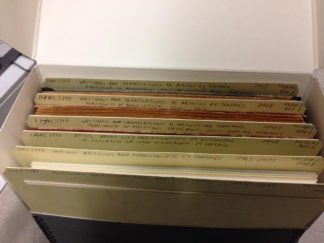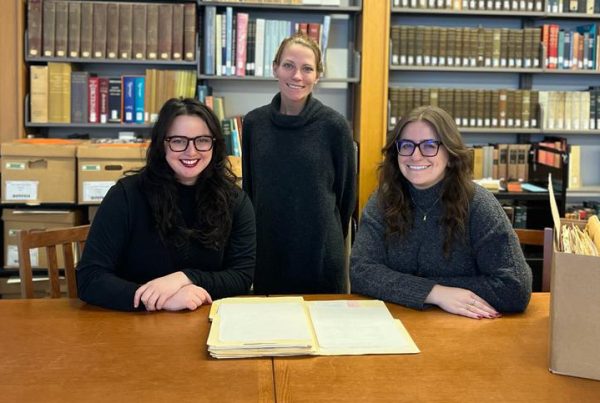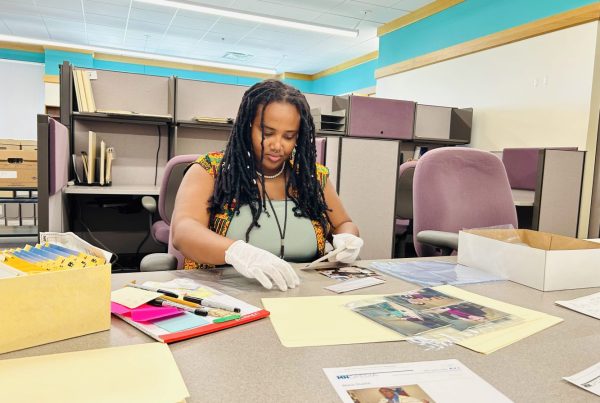By Daniel Necas
Archivist, Immigration History Research Center Archives
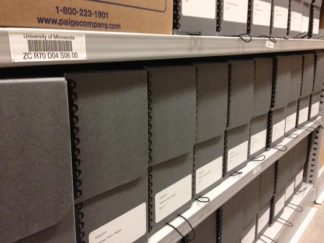
Hollinger boxes on the shelves holding the processed Heino Taremäe Papers.
Between September 15 and October 14, the IHRC Archives hosted two archivists from the National Archives of Estonia in Tallinn. This was year seven of this program, which was started in 2009. The visits have occurred annually with the exception of the year 2015. So far, we have met 10 archivists participating in the two-member teams from the National Archives, four colleagues from Tallinn have made two visits.
This year, Pille Aguraiuja and Külli Niidassoo worked with us daily from 8:30 to 4:30 for four weeks, helping us process Estonian-language collections. Pille had participated in the program once previously, in 2014 — however, both archivists from Estonia used our new content management system — Archives Space — for the first time.
Their initial training was provided by Lisa Calahan of the Central Processing Unit in Archives and Special Collections. Pille and Külli went to the training session perhaps still slightly jet-lagged, 18 hours after their landing at the Minneapolis-St. Paul International airport in the evening on Thursday, September 15, after a 24-hour journey. (Guarantees can be made by IHRCA’s Daniel Necas that their transportation from the airport to the Wales House near campus, their home for the subsequent four weeks, was as fast as legally possible on Minnesota roads.) Eager to work the next day (as usual with all archivists from Tallinn so far), Pille and Külli breezed through the training unfazed, and Archives Space became their “friendly archives management tool” indeed.
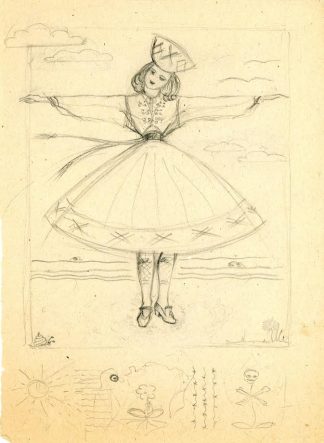
Drawing of an Estionian national costume, from the Linda Ormisson Papers
During their time at the IHRC Archives this year, Pille and Külli processed 13 collections of personal papers one to 15 linear feet in size, acquired in the past decade from the Estonian Archives in the United States, located in Lakewood, New Jersey. The creators and compilers of the materials were mostly refugees from Estonia who arrived in the United States as displaced persons in the late 1940s and early 1950s. Eventually, they found careers in a wide range of professions: construction company field instructor, music composer, gardener, teacher, boy scout instructor, actor, painter, graphic designer, librarian, journalist, chemist or accountant. The materials often document the dramatic years of World War II and the flight of Estonians from their country occupied alternatively by Germany and the Soviet Union, as well as their life in the new homelands. Many of them ultimately resettled in other parts of Europe, the United States and Australia. Their movement around the world is reflected in the variety of languages in which the documents were written. While the majority of the documentation is in Estonian, other languages such as English, German, Swedish, French, Russian, Finnish, Hungarian, Danish or Polish are represented as well. The collections also provide a good picture of the rich cultural and social life of the Estonian diaspora maintained by many organizations established around the United States and the world.
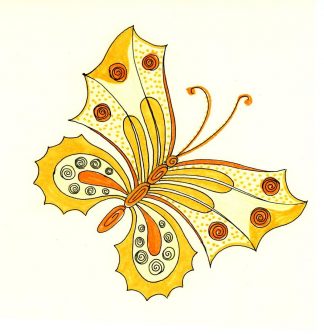
Butterfly drawing from the Linda Ormisson Papers
The international cooperation of the IHRC Archives and the Estonian National Archives, including this year’s visit, would not be possible without the generous support from the National Archives in Tallinn, the Lakewood Estonian Archives in the USA, the BaltHerNet Foundation and the multi-faceted assistance by the staff of the IHRC Archives and the Archives and Special Collections Department of the University of Minnesota Libraries, the International Student and Scholar Services office at the University of Minnesota and the local Estonian American community. This collaboration has resulted in over 300 individual collections of personal papers and organizational records processed since 2009, significantly enhancing access to these collections and their usability for future on-site and off-site researchers.


